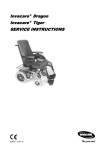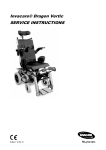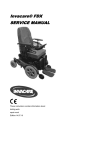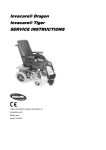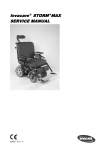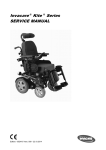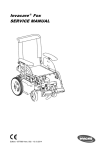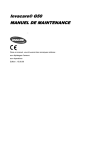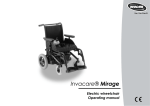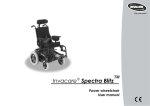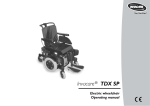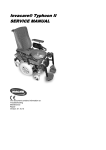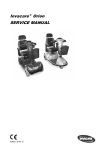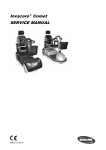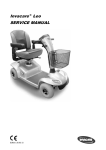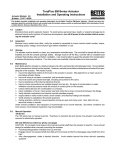Download 5 - Invacare
Transcript
Invacare® G50 SERVICE INSTRUCTIONS These instructions contain information on: Test work Repair work Edition: 15.08.06 : +43 6232 55 35 0 Herzog Odilostrasse 101 Fax: +43 6232 55 35 4 A-5310 Mondsee @: Austria @: Mobitec Mobilitätshilfen GmbH [email protected] [email protected] WWW: www.mobitec-austria.com : +32 (0)50 83 10 10 Autobaan 22 Fax: +32 (0)50 83 10 11 B-8210 Loppem (Brugge) @: Belgium WWW: Invacare® n.v. [email protected] www.invacare.be : +41 (0)61 48 77 08 0 Benkenstraße 260 Fax: +41 (0)61 48 77 08 1 CH-4108 Witterswil @: [email protected] Switzerland @: [email protected] Mobitec Rehab AG WWW: www.mobitec-rehab.ch +49 (0)75 62 7 00 0 Invacare Aquatec Alemannenstraße 10 Fax 88316 Isny @: Deutschland WWW: +49 (0)75 62 7 00 66 [email protected] www.invacare-aquatec.de (Kundeservice): Invacare® A/S Sdr. Ringvej 37 Fax (Kundeservice): DK-2605 Brøndby @: Danmark WWW: +45 (0)36 90 00 00 +45 (0)36 90 00 01 [email protected] www.invacare.dk : +34 (0)972 49 32 00 c/ Areny, s/n Fax: +34 (0)972 49 32 20 Polígon Industrial de Celrà @: E-17460 Celrà (Girona) WWW: Invacare® SA [email protected] www.invacare.es ESPAÑA : +33 (0)247 62 64 66 Route de St Roch Fax: +33 (0)247 42 12 24 F-37230 Fondettes @: France WWW: Invacare® Poirier SAS (Customer Service): Invacare® Ltd 2 [email protected] www.invacare.fr +44 (0)1656 776 222 Pencoed Technology Park Fax (Customer Service): Pencoed @: +44 (0)1656 776 220 [email protected] Bridgend CF35 5HZ @: [email protected] United Kingdom WWW: www.invacare.co.uk : +39 0445 38 00 59 Via Dei Pini, 62 Fax: +39 0445 38 00 34 I - 36016 Thiene (VI) @: ITALIA WWW: Invacare Mecc San s.r.l. [email protected] www.invacare.it : +353 18 10 70 84 Unit 5 Seatown Business Campus Fax: +353 18 10 70 85 Seatown Rd, Swords @: County Dublin WWW: Invacare Ireland Ltd. [email protected] www.invacare.ie Ireland (Kundeservice): Invacare® AS Grensesvingen 9 Fax (Kundeservice): Postboks 6230 @: Etterstad WWW: +47 (0)22 57 95 00 +47 (0)22 57 95 01 [email protected] www.invacare.no N-0603 Oslo Norge Invacare® B.V. : +31 (0)318 69 57 57 Celsiusstraat 46 Fax: +31 (0)318 69 57 58 NL-6716 BZ Ede @: Nederland WWW: Invacare Portugal, Lda [email protected] www.invacare.nl : +351 225 1059 46 : +351 225 1059 47 Rua Estrada Velha, 949 P-4465-784 Leça do Balio Fax: Portugal @: WWW: +351 225 1057 39 [email protected] www.invacare.pt 3 (Kundtjänst): Återförsäljare: +46 (0)8 761 70 90 Invacare® AB Fax (Kundtjänst): +46 (0)8 761 81 08 Fagerstagatan 9 @: [email protected] S-163 91 Spånga @: [email protected] Sverige WWW: Tillverkare: MÖLNDAL www.invacare.se : +46 (0)31 86 36 00 Kleiststraße 49 Fax: +46 (0)31 86 36 06 D-32457 Porta Westfalica @: Invacare® Deutschland GmbH [email protected] Deutschland LANDSKRONA : +46 (0)418 285 40 Fax: +46 (0)418 180 89 @: [email protected] OSKARSHAMN : Fax: @: 4 +46 (0)491 101 40 +46 (0)491 101 80 [email protected] Table of Contents Chapter Page TABLE OF CONTENTS 5 1 8 INTRODUCTION 1.1 General information 8 1.2 Notes on transport 8 1.3 Definition and representation of information and safety information in this manual 9 1.4 Hazard symbols and symbols used 10 1.5 Images in this manual 11 2 SAFETY AND FITTING INSTRUCTIONS 12 2.1 Before any inspection or repair work 12 2.2 Personal safety equipment 12 2.3 General safety information and information about fitting / removal 12 3 TIGHTENING TORQUES 14 4 ALLOCATION OF THE SUB-ASSEMBLIES AND COMPONENTS 15 5 MAINTENANCE PLAN (ONCE A YEAR) 16 6 OPERATIONAL FAULTS 19 6.1 6.1.1 6.1.2 6.1.3 7 Operational faults on wheelchair with ACS Diagnosing drive faults Diagnosing problems with electric actuators Error Codes and Diagnostic Codes REPAIR WORK 19 19 21 22 26 7.1 General warning information on installation work 26 7.2 7.2.1 7.2.2 Replacing front cowling Disassembly Assembly 27 27 28 7.3 7.3.1 7.3.2 Replacing rear cowling / replacing rear lights Disassembly Assembly 29 29 30 5 7.4 7.4.1 7.4.2 7.4.3 7.4.4 Replacing the side cowling Placing seat in service position Remove the rear cowling Removing the side cowling Assembly 31 31 32 33 36 7.5 7.5.1 7.5.2 7.5.3 Replacing the headlights Placing seat in service position Unmounting the headlights Assembly 37 37 38 40 7.6 7.6.1 7.6.2 Replacing a motor Disassembly Assembly 41 41 46 7.7 7.7.1 7.7.2 7.7.3 7.7.4 Replacing the rear rocker / adjusting toe and camber Disassembly Assembly Adjusting the camber Adjusting the toe-in 48 48 51 52 52 7.8 7.8.1 7.8.2 Replacing the front shock absorbers Disassembly Assembly 54 54 57 7.9 7.9.1 7.9.2 7.9.3 Replacing the Bowden cable of the hand brake / adjusting the brake Replacing the Bowden cable Assembly Adjusting the hand brake 59 59 63 63 7.10 Replacing the Bowden cable of the declutching mechanism 7.10.1 Replacing the Bowden cable 7.10.2 Assembly 65 65 69 7.11 Replacing the seat frame (EBAS) 7.11.1 Placing seat in service position 7.11.2 Disassembly 7.11.3 Assembly 70 70 72 76 7.12 Replacing electronics components 7.12.1 Replacing the power module 7.12.2 Replacing other electronic components 77 77 77 7.13 Changing the batteries 7.13.1 Tilting the seating system forward 7.13.2 Removing the batteries 7.13.3 Connecting the New Batteries 7.13.4 How to handle damaged batteries correctly 79 81 82 83 84 7.14 Checking and replacing the main fuse 7.14.1 Placing seat in service position 85 85 7.15 Checking the cables 7.15.1 Placing seat in service position 88 88 7.16 Replacing the ACS Remote 91 7.17 Updating the driving program 93 6 7.18 Retrofitting the joystick left/right 7.18.1 Placing seat in service position 7.18.2 Retrofitting 94 94 95 7.19 Repairing a flat tyre 7.19.1 Repairing a flat tyre (type 4.00-8" pneumatic tyres) 7.19.2 Repairing a flat tyre (type 3.10/4.50-6 pneumatic tyres) 98 98 100 7.20 Replacing the safety belt 102 7.21 Testing an actuator motor 102 8 8.1 REFURBISHMENT 103 Configuration table 103 7 1 Introduction 1.1 General information • Service and maintenance work must be carried out taking this service manual into account. • It is imperative that you observe safety information. • Information about operation or about general maintenance and care work on the mobility aid should be taken from the operating manual. • You can find information about ordering spare parts in the spare parts catalogue. • Only use original Invacare® spare parts. The guarantee will become invalid if other spare parts are used! • We reserve the right to make any alterations on the grounds of technical improvements. • The mobility aid may only be maintained and overhauled by qualified personnel. • The minimum requirement for service technicians is suitable training, such as in the cycle or orthopaedic mechanics fields, or sufficiently long-term job experience. - Experience in the use of electrical measuring equipment (multimeters) is also a requirement. - Special Invacare® training is recommended. • Alterations to the mobility aid which occur as a result of incorrectly or improperly executed maintenance or overhaul work lead to the exclusion of all liability on the side of INVACARE. • If you have any problems or questions please contact Invacare® Service. 1.2 Notes on transport 8 • If the mobility aid has to be shipped back to the manufacturer for major repairs, you should always use the original packaging for transport. • Please attach a precise description of the fault. 1.3 Definition and representation of information and safety information in this manual Different types of information and signal words are used throughout this manual. HAZARD! The signal word "HAZARD!" refers to immediate hazards. • The following lines in italics refer to actions which serve to avoid such hazards. WARNING! The signal word "WARNING!" refers to possibly-occurring hazards which can lead to death or serious injuries if they are not avoided. • The following lines in italics refer to actions which serve to avoid such hazards. ATTENTION! The signal word " ATTENTION!" refers to possibly-occurring hazards which can lead to minor injuries and/or material damage if they are not avoided. • The following lines in italics refer to actions which serve to avoid such hazards. CAUTION! The signal word "CAUTION!" refers to hazards which could lead to material damage if they are not avoided. • The following lines in italics refer to actions which serve to avoid such hazards. Note The signal word "Note" is used to denote general information which simplifies the handling of your product and refers to special functions. 9 1.4 Hazard symbols and symbols used Different types of hazard symbols and symbols are used throughout this manual. General hazards This symbol warns you of general hazards! • Always follow the instructions to avoid injury to the user or damage to the product! BURN HAZARD! This symbol warns you of the danger of chemical burns, for example due to the discharge of battery acids! • Always follow the instructions to avoid injury to the user or damage to the product! DANGER OF CRUSHING! This symbol warns you of crushing hazards due to inattentive working with heavy components. • Always follow the instructions to avoid injury to the user or damage to the product! EXPLOSION HAZARD! This symbol warns you of an explosion hazard, which can be caused by excessive tyre pressure in a pneumatic tyre. • Always follow the instructions to avoid injury to the user or damage to the product! Wear safety shoes The symbol refers to the requirement for wearing safety shoes. • Wear standardised safety shoes during all work. Wear eye protection This symbol refers to the requirement for wearing eye protection, for example when working with batteries. • Wear eye protection when this symbol is shown. Wear safety gloves This symbol refers to the requirement for wearing safety gloves, for example when working with batteries. • Wear safety gloves when this symbol is shown. Note This symbol identifies general information which is intended to simplify working with your product and which refers to special functions. Requirements: • This symbol identifies a list of various tools, components and items which you will need in order to carry out certain work. Please do not attempt to carry out the work if you do not have the listed tools available. Always dispose used or damaged batteries correctly The symbol refers to information for the correct disposal of used or damaged batteries. 10 1.5 Images in this manual The detailed images in this manual are given digits to identify various components. Component numbers in text and operational instructions always relate to the image directly above. 11 2 Safety and fitting instructions These safety instructions are intended to prevent accidents at work, and it is imperative that they are observed. 2.1 Before any inspection or repair work • Read and observe this repair manual and the associated operating manual! • Observe the minimum requirements for carrying out the work (see chapter entitled „General information)! 2.2 Personal safety equipment Safety shoes The mobility device, and some of its components, are very heavy. These parts can result in injuries to the feet if they are allowed to drop. • Wear standardised safety shoes during all work. Eye protection It is possible that battery acid can be discharged when working on defective batteries or when handling batteries improperly. • Always wear eye protection when working on any defective or possibly defective batteries. Safety gloves It is possible that battery acid can be discharged when working on defective batteries or when handling batteries improperly. • Always wear acid-proof safety gloves when working on any defective or possibly defective batteries. 2.3 General safety information and information about fitting / removal WARNING: Danger of crushing! Various components such as the drive unit, batteries, seat etc are very heavy. This results in injury hazards to your hands! • Please note the high weight of some components! This applies especially to the removal of drive units, batteries and the seat. WARNING! Injury hazard if the vehicle starts moving unintentionally during repair work! • Switch the power supply off (ON/OFF key)! • Engage the drive! • Before raising the vehicle, secure the wheels by blocking them with wedges! ATTENTION! Fire and burn hazard due to electrical short-circuit! • The mobility device must be completely switched off before removal of voltage-carrying components! To do this, remove the batteries. • Avoid short-circuiting the contacts when carrying out measurements on voltage-carrying components! 12 ATTENTION! Injury hazard and danger of damage to vehicle due to improper or incomplete maintenance work! • Use only undamaged tools in good condition. • Some moving parts are mounted in sockets with PTFE coating (Teflon™). Never grease these sockets! • Never use "normal" nuts instead of self-locking nuts. • Always use correctly-dimensioned washers and spacers • When reassembling, always replace any cable ties which were cut during dismantling. • After completing your work / before renewed start-up of the mobility device, check all connections for tight fitting. • After completing your work / before renewed start-up of the mobility device, check all parts for correct locking. • Only operate the vehicle with the approved tyre pressures (see technical data). • Check all electrical components for correct function. Please note that incorrect polarity can result in damage to the electronics. • Always carry out a trial run at the end of your work. Note Mark all current settings for the mobility aid (seat, armrests, backrest etc.), and the associated cable connecting plugs, before dismantling. This makes reassembly easier. All plugs are fitted with mechanical safety devices which prevent release of the connecting plugs during operation. To release the connecting plugs the safety devices must be pressed in. When reassembling ensure that these safety devices are correctly engaged. WARNING! Any changes to the drive program can affect the driving characteristics and the tipping stability of the vehicle! • Changes to the drive program may only be carried out by trained Invacare® specialist dealers! • Invacare® supplies all mobility aids with a standard drive program ex-works. Invacare® can only give a warranty for safe vehicle driving behaviour - especially tipping stability - for this standard drive program! 13 3 Tightening torques The tightening torques stated in the following list are based on the thread diameter for the nuts and bolts for which no specific values have been determined. All values assume dry and de-greased threads. Thread M4 M5 M6 M8 M10 M12 Tightening torque in Nm ±10% 3 Nm 6 Nm 10 Nm 25 Nm 49 Nm 80 Nm M14 M16 120 Nm 180 Nm CAUTION! Damage can be caused to the mobility device due to improperly tightened screws, nuts or plastic connections. • Always tighten screws, nuts etc to the stated tightening torque. • Only tighten screws or nuts which are not listed here fingertight. 14 4 Allocation of the sub-assemblies and components Under the seat: 1) Batteries 2) Main fuse 3) Drive Under the rear cowling 4) CLAM (Combined Light and Actuator Module) (only installed if the wheelchair is equipped with electric adjustment options) 5) Steering servo 6) Power module (partially covered in picture) 7) Servo-Light-Module 15 5 Maintenance plan (once a year) Component Check for Measures • Damage / wear • Replace Seating Unit Armrests / Armrest pads Backrest (Cushion / Sling) Backrest (Frame, Fixation parts) Seat cushion Actuator / actuator cable (if available) • Check that all screws are • Tighten tight • Damage / wear • Replace • Damage / wear • Replace • Check that all screws are • Tighten tight • Damage / wear • Replace • Damage • Replace • Function • Check that the cable is firmly connected, if necessary replace cable or actuator (See "Testing an actuator motor" on page 102) • Check function of the CLAM, if necessary replace CLAM (See "Replacing electronics components" on page 77) • Check that all screws are • Tighten tight Opening mechanism of the seat unit (Easy Battery Access system) Unlocking mechanism Swing-up mechanism, latching mechanism, gas pressure spring • Damage, correct function • Replace damaged/worn parts • Damage, correct function • Replace • Check that all screws are • Tighten tight Electrical System Driving Programme Batteries / battery cable 16 • Check the programme version of the driving electronics. Is there a newer version available? • Damage • Update the software. See "Updating the driving program" on page 93 • replace (See "Changing the batteries" on page 79) Component Battery fixation belts / buckles Cables / cable looms Joystick box / bus cable Check for Measures • Battery voltage • Charge batteries • Check that the cable clamps are firmly attached to the battery terminals • Damage • Tighten • Firmly attached • Tighten • Damage • Replace • Plug-in connections are firmly connected • Firmly press the connection together (See "Checking the cables" on page 88) • Replace • Damage • Replace • Check that all plug-in connections are firmly connected Lighting • Firmly press the plug-in connection together (See "Checking the cables" on page 88) • Check that all screws are • Tighten tight • Function • Send in to Invacare to be repaired, if necessary replace (See "Replacing the ACS Remote" on page 91) • Light bulbs defective • Replace • Casing / glass damaged • Replace • Position / angle out of adjustment • Adjust Frame Frame (chassis) / Battery cradle • Check fixation, weld • Tighten screws, replace seams and battery cradle components for damage Wheels / Tyres Drive wheels Steering wheels Pneumatic tyres • Check for tight fit and axial run out • Check for tight fit, check required motor-to-body clearance and axial run out • Damage • Adjust • Replace wheels or wheel bearings. • Repair or replace, if damaged (See "Repairing a flat tyre" on page 98) Steering mechanism 17 Component Steering connecting rods / steering connecting rod heads Servo Check for Measures • Damage • Replace • Check that all screws are • Tighten tight • Function • Check that the plug-in connection of the servo cable is firmly connected, if necessary replace the cable or servo • Check the function of the Servo-Light-Module, if necessary replace Drive Drive unit Coupling mechanism Parking brake • Function • Check coupling mechanism • Function • Function • Replace (See "Replacing a motor" on page 41) • Tighten screws/nuts, adjust or replace if necessary • Adjust, if necessary replace damaged part • Adjust Legrests Legrests Actuator (on electric legrests) 18 • Check welding seams, • Replace locking devices, foot plates for damage • Check that all screws are • Tighten tight • Check functions • Replace actuator/cable (See "Testing an actuator motor" on page 102) • Clean and check the contacts of the legrest mounting brackets, if necessary replace. 6 Operational Faults 6.1 Operational faults on wheelchair with ACS In the event of problems with the wheelchair, please proceed as follows: • Begin by assessing the possible cause of disturbance on the basis of the following tables. • Check the remote status display. Evaluate the flashing error code. • Carry out the necessary examinations and repairs as recommended in the following table. 6.1.1 Diagnosing drive faults PROBLEM OTHER SYMPTOMS POSSIBLE CAUSE SOLUTION DOCUMENTATION Wheelchair will not start up Status display on the remote illuminates as usual and does not display an error code Drive motor possibly faulty • Replace drive motor See "Replacing a motor" on page 41 • Replace batteries See "Changing the batteries" on page 79 Status display Batteries on the remote is possibly faulty not illuminated Battery possibly • Recharge batteries deep-discharged See instruction manual Power supply to • Check main fuse remote possibly interrupted See "Checking and replacing the main fuse" on page 85 • Check cable between the modules for loose connections or damage • Replace Remote possibly remote on the faulty wheelchair in order to exclude the possibility that the remote is the cause. Status display Various causes • Evaluate error code on the remote is flashing See "Checking the cables" on page 88 See "Replacing the ACS Remote" on page 91 See "Error Codes and Diagnostic Codes" on page 22 19 PROBLEM Wheelchair judders during drive operation Batteries are not being charged OTHER SYMPTOMS None POSSIBLE CAUSE SOLUTION DOCUMENTATION Batteries possibly faulty (unstable voltage) • Replace batteries See "Changing the batteries" on page 79 Drive motor(s) possibly faulty • Replace motor See "Replacing a motor" on page 41 None Batteries possibly faulty • Replace batteries See "Changing the batteries" on page 79 LEDs flashing on charger Charger possibly • Replace charger faulty See charger instruction manual None Remote possibly • Replace remote faulty See "Replacing the ACS Remote" on page 91 Battery possibly • Recharge deep-discharged batteries Pre-charge batteries with a commercially available battery charger. Batteries possibly faulty 20 • Replace batteries See "Changing the batteries" on page 79 6.1.2 Diagnosing problems with electric actuators Assess the cause of the fault involving an electric adjustment motor on the basis of the following table: PROBLEM OTHER SYMPTOMS Electric adjustment motor not reacting Remote displays Light flashing "E", /adjustment status diode on module faulty light/adjustment module does not extinguish even if the remote is shut down or disconnected None POSSIBLE CAUSE SOLUTION DOCUMENTATION Replace See "Replacing lighting/adjustment electronics components" module on page 77 Cable possibly severed or damaged • Check that See "Checking the cables" the cable on page 88 has not been severed or damaged. Replace cable if necessary Electric adjustment motor possibly faulty • See "Testing an actuator Test adjustmen motor" on page 102 t motor Remote possibly faulty • See "Replacing the ACS Replace remote on Remote" on page 91 wheelchair in order to exclude the possibility that the remote is the cause of the disturbanc e. 21 6.1.3 Error Codes and Diagnostic Codes 6.1.3.1 CLAM LED of the CLAM lights up constantly: Status display of the CLAM, (visible through hole (1)) CLAM is functioning correctly. LED of the CLAM is off: CLAM may not be connected. Check plug-in connections. The joystick box might be programmed with an incorrect driving programme (for example after having replaced the joystick box). Check driving programme. LED of the CLAM is flashing: CLAM is defective. Replace CLAM. 6.1.3.2 Joystick box / Servo-Light-Module If the electronic system detects a fault this is indicated by a combined flashing code on the remote and on the servo light module. Some faults can be remedied independently by the electronic system. For this purpose, please switch the remote off and then on again. Please wait approximately 5 seconds in each case before you switch the remote on again. If the fault can be remedied, the flashing will stop on the status display. If the fault cannot be remedied by this, please localise the fault by means of the following flashing codes. Status display of the remote (1) 22 Status display of the Servo-Light-Module (rear cowling removed) Remote status bar Servo light indicator LED blink module LED code blink code 1 2 3 4 5 Cause Fault remedy - ACS module defective • Replace faulty module See "Replacing electronics components" on page 77 1 Plug on servo light module (SLM) defective, or SLM defective • Replace faulty module See "Replacing electronics components" on page 77 2 Error at servo motor • Replace servo motor. - Faulty accessory (e.g. short circuit on adjustment motor) • Check accessory connections, check accessories See "Testing an actuator motor" on page 102 3 Potentiometer on servo motor • (steering) defective 4 Lighting system defective (error in SLM or in cabling) • Check cable, replace SLM. See "Replacing electronics components" on page 77 5 Steering disengaged • Re-engage the steering: Switch the electronics system off and on again. - Motor connection loose/defective or motor defective (M1) • Check the connecting plug See "Checking the cables" on page 88 • Replace motor See "Replacing a motor" on page 41 • Check the connecting plug See "Checking the cables" on page 88 • Replace motor See "Replacing a motor" on page 41 • Engage motor. Switch the electronics system off and on again. • Check the connecting plug • Replace motor See "Replacing a motor" on page 41 - - Motor connection loose/defective or motor defective (M2) Magnetic brake defective or drive disengaged Replace potentiometer. 23 Remote status bar Servo light indicator LED blink module LED code blink code 6 7 8 - 24 • Engage motor. Switch the electronics system off and on again. • Check the connecting plug • Replace motor See "Replacing a motor" on page 41 • Charge battery. See User' Manual Battery voltage too low 7 Battery voltage too low (below • 17V) - Check battery connections • Check fuses. • Check batteries and replace if necessary. See User' Manual Battery voltage too high • Turn on lighting CANL error • Check bus cable/data cable for short circuit. An open circuit or a short circuit in one of the ACSModules can also cause this error. See "Checking the cables" on page 88 and "Replacing electronics components" on page 77 9 CANL error problems on the • CANL channel / communication over CANL not possible. - CANH error • Check bus cable/data cable for short circuit. An open circuit or a short circuit in one of the ACSModules can also cause this error. See "Checking the cables" on page 88 and "Replacing electronics components" on page 77 CANH error problems on the CANH channel / communication over CANH not possible. • Check bus cable for continuity Maximum current time-out (drive overloaded or overheated) • Switch the electronics system off and on again. 10 11 Magnetic brake defective or drive disengaged Fault remedy - 9 10 Cause - Check bus cable for continuity Remote status bar Servo light indicator LED blink module LED code blink code 11 12 - Cause Fault remedy Maximum current time-out (servo motor overloaded or overheated) • Switch the electronics system off and on again. Compatibility problems between ACS modules • Remove all electronic modules except the Power Module and the Remote. Re-attach modules one by one to determine which one is causing the fault. Remove incorrect module See "Replacing electronics components" on page 77 25 7 Repair Work 7.1 General warning information on installation work CAUTION! Risk of damage to the vehicle! Collisions can be caused if shim rings are removed from the drive wheels during installation work! Shim rings are frequently placed between the drive shaft and the wheel hub to compensate tolerances. Collisions can be caused if these shim rings are removed and not re-installed! • Install all shim rings in exactly the same positions they were in before dismantling. 26 7.2 Replacing front cowling Requirements: • Open-end spanner 13 mm NOTE Please keep small parts such as screws and grommets safe during dismantling. Lay all small parts down in such a way that they can be re-fitted in the correct order. 7.2.1 Disassembly Removing the swing-away legrests • Press the unlocking button (1) and swivel the footrest outward. • Remove the footrest in an upward direction. Removing the fixed legrests • Loosen the fixation screw with open-end spanner 13 mm. • Pull legrest out toward the front. • Loosen and remove the knurled screws (A). 27 • Pull the cowling upward and forwards and remove. 7.2.2 Assembly The process of re-assembly is done in reverse order. 28 7.3 Replacing rear cowling / replacing rear lights Requirements: • 8mm open-ended spanner NOTE Please keep small parts such as screws and grommets safe during dismantling. Lay all small parts down in such a way that they can be re-fitted in the correct order. 7.3.1 Disassembly • Loosen and remove the knurled screws (A). • Pull cowling upwards and backwards. • Disconnect the plug-in connections (1) of the rear lighting. 29 In case the existing rear lighting is to be reemployed: • Loosen and remove the fixation nuts (1) of the rear lights using the open-end spanner 8 mm. • Remove rear lights. 7.3.2 Assembly The process of re-assembly is done in reverse order. NOTE Pay attention to RIGHT and LEFT when re-connecting the plug-in connections of the rear light cables. 30 7.4 Replacing the side cowling Requirements: • 8mm open-ended spanner • 3 mm Allen key • 6 mm Allen key • Diagonal-nosed cutting pliers • Cable ties • Phillips screwdriver Note Please keep small parts such as screws and grommets safe during dismantling. Lay all small parts down in such a way that they can be re-fitted in the correct order. 7.4.1 Placing seat in service position • Use the Allen key 6 mm to loosen the screws (1) on both sides and remove. The seat release button is to be found at the front underneath the edge of the seat (2). CAUTION! Damage to the wheelchair due to careless tipping of seat! • When tipping the seat, make sure the fixation brackets of the backrest do not damage the side or rear cowlings! 31 • Press the release button and tip the seat backward carefully. • Carefully pull the seat upward and to the front. Depending on the position of the tilt of the seat, this will remain in the position shown on the right or it will swivel further to the front. 7.4.2 Remove the rear cowling To access the rear fixation bolts of the side handles, the rear cowling needs to be removed. 32 • Loosen and remove the knurled screw (A). • Pull cowling upwards and backwards. • Disconnect the plug-in connections (1) of the rear lighting. 7.4.3 Removing the side cowling With a cane holder • Loosen and remove the fixation screws of the cane holder, using the open-end spanner 8 mm. • Loosen and remove the additional lateral fixation screws of the side cowling (2, concealed by the cane holder in the picture) with the Allen key 3 mm . 33 Without a cane holder • Use the Allen key 3 mm to loosen and remove the lateral fixation screws (1) of the side cowling. • Use the Allen key 6 mm to loosen and remove the lateral fixation bolts (1) of the side handle. • Cut the cable binder (1) of the headlight cable with the pair of side cutters. • Loosen and remove the fixation screws (1) that hold the headlight, using the crosstip screwdriver. 34 • Both the bus cable of the joystick box, as well as the headlight cable are held by two cable clips on the under side of the frame tube (visible from the inside). • Carefully pull out the bus cable and headlight cable. • Cut the cable binder (1) with the pair of side cutters. • Disconnect the plug of the headlight cable from the plug-in connection circuit board. 35 • Carefully pull the headlight cable out of the opening in the side cowling. • Seitenverkleidung entfernen. 7.4.4 Assembly • Re-assembly is done in reverse order. • Fasten all cables with cable ties again. • Test all functions of the wheelchair. 36 7.5 Replacing the headlights Requirements: • 6 mm Allen key • Diagonal-nosed cutting pliers • Cable ties • Phillips screwdriver Note Please keep small parts such as screws and grommets safe during dismantling. Lay all small parts down in such a way that they can be re-fitted in the correct order. 7.5.1 Placing seat in service position • Use the Allen key 6 mm to loosen the screws (1) on both sides and remove. The seat release button is to be found at the front underneath the edge of the seat (2). CAUTION! Damage to the wheelchair due to careless tipping of seat! • When tipping the seat, make sure the fixation brackets of the backrest do not damage the side or rear cowlings! 37 • Press the release button and tip the seat backward carefully. • Carefully pull the seat upward and to the front. Depending on the position of the tilt of the seat, this will remain in the position shown on the right or it will swivel further to the front. 7.5.2 Unmounting the headlights • Cut the cable binder (1) of the headlight cable with the pair of side cutters. 38 • Loosen and remove the fixation screws (1) that hold the headlight, using the crosstip screwdriver. • Both the bus cable of the joystick box, as well as the headlight cable are held by two cable clips on the under side of the frame tube (visible from the inside). • Carefully pull out the bus cable and headlight cable. • Cut the cable binder (1) with the pair of side cutters. 39 • Disconnect the plug of the headlight cable from the plug-in connection circuit board. • Carefully pull the headlight cable out of the opening in the side cowling. 7.5.3 Assembly • Re-assembly is done in reverse order. • Fasten all cables with cable ties again. • Test all functions of the wheelchair. 40 7.6 Replacing a motor WARNING: Danger of crushing! The mobility device is very heavy. Injury hazard to hands and feet! • You should seek help from a second person. Injury hazard caused by uncontrolled movement of the mobility device! • Switch the power supply off (ON/OFF key). • Engage the drive. • Before raising the vehicle, secure the wheels by blocking them with wedges. • When jacking up the wheelchair please use a block of wood that is large enough to provide large-area support to the wheelchair under the battery box. This improves the tilt resistance of the wheelchair during repair work. Requirements: • 6mm open-ended spanner • Open-end spanner 13 mm • Open-end spanner 10 mm • Allen key with ball end 3 mm • Allen key 5 mm • Allen key 8 mm • Ratchet • Socket 19 mm • Socket 17 mm • Small, flat screwdriver • Side cutters • Cable binders • 4 x wooden blocks (approx. 12 x 12 x 30 cm) to the jack up of the vehicle and the drive unit NOTE Please keep small parts such as screws and grommets safe during dismantling. Lay all small parts down in such a way that they can be re-fitted in the correct order. 7.6.1 Disassembly Removing the swing-away legrests • Press the unlocking button (1) and swivel the footrest outward. • Remove the footrest in an upward direction. 41 Removing the fixed legrests • Loosen the fixation screw with open-end spanner 13 mm. • Pull legrest out toward the front. • Loosen and remove the knurled screws (A). • Pull the cowling upward and forwards and remove. • Activate the hand brake (1). 42 • Jack up wheelchair with wooden blocks under the battery compartment. • Carefully pry the hub caps off of the drive wheels with the small, flat screwdriver. • Remove the fixation bolt of the wheel hubs with the socket spanner 19 mm. • Loosen and remove the lower fixation bolt of the shock absorber with two open-end spanners 13 mm. 43 • Secure the drive unit with wooden blocks against falling down. • The brake is held by four screws (1). • Loosen and remove the screws, using the Allen key with ball end 3 mm. • Pull the brakes (1) on both side off in an outward direction. 44 • Loosen and remove the fixation bolts of the drive unit on both side with the Allen key 8 mm and socket spanner 17 mm. • Loosen and remove the fixation screw of the ground lead (1) with the Allen key 5 mm and the open-end spanner 10 mm. • Cut the cable binder (1) of the motor cable with the pair of side cutters. • Disconnect the plug-in connections (2) of the motor cable at the power module • Pull off the protective cap (1) of the declutching bowden cable, or cut it off with the side cutters. • Loosen the fixation screw of the adjustment sleeve (2) of the declutching bowden cable with the small, flat screwdriver and the openend spanner 6 mm. Pull off adjustment sleeve. 45 ATTENTION: Danger of injury by crushing! The dive unit is very heavy. Danger of injury to your hands! • Please give consideration to the great weight. • The drive unit can now be removed by pulling it out towards the front. 7.6.2 Assembly The process of re-assembly is done in reverse order. • Position the new drive unit on the wooden blocks. • Position the brakes on the axles. • Insert fixation bolts of the drive unit and loosely fasten with the nuts. • Mount wheels (fixation nuts do not need to be completely tightened yet) • Activate hand brake. ################################################################ !!!HIER LÄUFTS AUSEINANDER !!! ################################################################ 46 • Tighten the fixation bolts (2) of the drive unit with the Allen key 8 mm and socket spanner 17 mm. • Further assembly of the motor is carried out in reverse order to disassembly. • Secure the motor cable using a new cable tie. • Make sure that the fixation nuts of the drive wheels are completely tightened! • Adjust the brake (see chapter "Replacing the Bowden cable of the hand brake / adjusting the brake" on page 56)! • Perform a test-drive. 47 7.7 Replacing the rear rocker / adjusting toe and camber WARNING: Danger of crushing! The mobility device is very heavy. Injury hazard to hands and feet! • You should seek help from a second person. Injury hazard caused by uncontrolled movement of the mobility device! • Switch the power supply off (ON/OFF key). • Engage the drive. • Before raising the vehicle, secure the wheels by blocking them with wedges. • When jacking up the wheelchair please use a block of wood that is large enough to provide large-area support to the wheelchair under the battery box. This improves the tilt resistance of the wheelchair during repair work. Requirements: • Open-end spanner 13 mm • Open-end spanner 17 mm • 24 mm open-ended spanner • Open-end spanner 38 mm • 6 mm Allen key • 10 mm Allen key • Water pump pliers • Needle nose pliers • Mechanic's level, if possible digital • Rail or bar, approx. 120 cm long, made of aluminium or steel, to adjust the wheel toe. The rail must be absolutely straight! • 2 Wooden blocks (approx. 12 x 12 x 30 cm) for jacking up the vehicle • High strength anaerobic metal adhesive (threadlocker), such as Loctite 2701 or OmniFit 200 Note Please keep small parts such as screws and grommets safe during dismantling. Lay all small parts down in such a way that they can be re-fitted in the correct order. 7.7.1 Disassembly • Loosen and remove the knurled screws (A). 48 • Pull cowling upwards and backwards. • Jack up wheelchair with wooden blocks under the battery compartment. All wheels must be clear of the ground and able to rotate freely. • Loosen the nut (1), using the open-end spanner 24 mm, while countering the axle (dowel screw) from the other side with the Allen key 10 mm so that it cannot turn. • Remove the wheel and the axle. 49 • The outer bushing (1) is not secured with anaerobic metal adhesive, only inserted loosely. • Loosen and remove the bushing (1), using the water pump pliers. • The inner bushing (1) is secured with metal adhesive and cannot be removed from the trailing arm. For this reason, the complete trailing arm must be replaced along with the bushing. • Counter the lower fixation bolt of the shock absorber (1), using an Allen key 6 mm, to prevent it from turning, and loosen and remove the nut (2), using the open-end spanner 13 mm. • Pull the bolt out. 50 • Counter the dowel screw (the pivotal point of the rocker) (1, not visible in the picture), using the Allen key 6 mm to prevent it from rotating, while using the open-end spanner 17 mm to loosen and remove the nut (2). • Pull the bolt out. • Remove the trailing arm. 7.7.2 Assembly • Replace the trailing arm with a new one (assembly is done in reverse order to disassembly). • When inserting the lower fixation bolt of the shock absorber, it can be helpful use a pair of needle nose pliers to position the spacer sleeves (1). • Apply anaerobic metal adhesive to the bushing and insert it into the trailing arm. • Place the spherical disk on the axle (dowel screw) with the flat side facing towards the wheel. • Assemble the wheel. Firmly tighten the fixation nut. 51 7.7.3 Adjusting the camber The optimum wheel camber is +0.5° (positive camber), and is set by rotating the bushing (1), using the open-end spanner 38 mm (alternatively, a ring spanner or a ratchet with a 38 mm socket can be used). This adjustment can be realised by rotating the bushing either clockwise or counter-clockwise. When the camber of the wheel is adjusted the toe-in also changes. For this reason, it is important to adjust the camber of the wheel in such a manner that the distance between the pivotal point screw of the trailing arm and the tyre is as great as possible. When the camber has been correctly adjusted, then you must wait at least one hour before driving the wheelchair, so that the metal adhesive has enough time to harden. Otherwise the camber will be out of adjustment. 7.7.4 Adjusting the toe-in centring the steering servo Before the toe-in can be adjusted, the steering servo must be centred. In order for the steering servo to centre itself, the drive wheels must have ground clearance and be able to rotate freely. • To centre the servo, switch on the driving electronics, pull the joystick straight back towards the rear and hold it in this position for 5 seconds. The servo will centre itself automatically during the simulated reverse drive. Afterwards, switch the driving electronics back off again. 52 Adjusting the toe-in The toe-in is adjusted by means of the steering connecting rod (1). • Loosen the counter nuts (2 and 3) of the steering connecting rod, using the open-end spanner 13 mm. Please note: The inner counter nut (3) has a left-hand thread! • Use the aluminium rail to check the toe-in. The position of the drive wheel on the same side serves as a reference. To do this, press the rail firmly against the drive wheel. • The toe-in is correctly adjusted when the clearance between the steering wheel tyre and the aluminium rail in the front area of the wheel (1) is approximately 3 mm more than in the rear (2). • Tighten the counter nut the steering connecting rod again. • Perform a test drive. 53 7.8 Replacing the front shock absorbers WARNING: Danger of crushing! The mobility device is very heavy. Injury hazard to hands and feet! • You should seek help from a second person. Injury hazard caused by uncontrolled movement of the mobility device! • Switch the power supply off (ON/OFF key). • Engage the drive. • Before raising the vehicle, secure the wheels by blocking them with wedges. • When jacking up the wheelchair please use a block of wood that is large enough to provide large-area support to the wheelchair under the battery box. This improves the tilt resistance of the wheelchair during repair work. Requirements: • Open-end spanner 13 mm • Ratchet • Socket 19 mm • Small, flat screwdriver • 4 x wooden blocks (approx. 12 x 12 x 30 cm) to the jack up of the vehicle and the drive unit NOTE Please keep small parts such as screws and grommets safe during dismantling. Lay all small parts down in such a way that they can be re-fitted in the correct order. 7.8.1 Disassembly Removing the swing-away legrests • Press the unlocking button (1) and swivel the footrest outward. • Remove the footrest in an upward direction. 54 Removing the fixed legrests • Loosen the fixation screw with open-end spanner 13 mm. • Pull legrest out toward the front. • Loosen and remove the knurled screws (A). • Pull the cowling upward and forwards and remove. • Activate the hand brake (1). 55 • Carefully pry the hub caps off of the drive wheels with the small, flat screwdriver. • Remove the fixation bolt of the wheel hubs with the socket spanner 19 mm. • Jack up wheelchair with wooden blocks under the battery compartment. • Loosen and remove the lower fixation bolt of the shock absorber with two open-end spanners 13 mm. 56 • Pry off the protective cap (1) of the fixation bolt of the shock absorber using the flat screwdriver. • Loosen and remove the upper fixation bolt of the shock absorber with two open-end spanners 13 mm. • Remove shock absorber 7.8.2 Assembly ATTENTION! Danger of material damage! The spring of the shock absorber must always be under tension. • If necessary, adjust the shock absorber by turning the adjustment knurled nut. 57 • The process of re-assembly is done in reverse order. • Perform a test-drive. 58 7.9 Replacing the Bowden cable of the hand brake / adjusting the brake Requirements: • Open-end spanner 8 mm • Open-end spanner 13 mm • Open-end spanner 10 mm • 3 mm Allen key • 6 mm Allen key • Phillips screwdriver • Diagonal-nosed cutting pliers • Cable ties • Wooden block (approx. 12 x 12 x 30 cm) for jacking up the vehicle Note Please keep small parts such as screws and grommets safe during dismantling. Lay all small parts down in such a way that they can be re-fitted in the correct order. 7.9.1 Replacing the Bowden cable Removing the swing-away legrests • Press the unlocking button (1) and swivel the footrest outward. • Remove the footrest in an upward direction. Removing the fixed legrests • Loosen the fixation screw with open-end spanner 13 mm. • Pull legrest out toward the front. 59 • Loosen and remove the knurled screws (A). • Pull cowling upward and forwards and remove. • Loosen and remove the knurled screws (A) of the rear cowling. • Pull cowling upwards and backwards. 60 To be able to access the Bowden cables of the hand brake, the side cowling on the side where the brake lever is located needs to be removed. • Cut the cable binder (1) of the headlight cable with the pair of diagonal-nosed cutting pliers. • Loosen and remove the fixation screws (1) that hold the headlight, using the crosstip screwdriver. • Use the Allen key 6 mm to loosen and remove the lateral fixation bolts (1) of the side handle. • Loosen and remove the fixation screws (1) of the brake and declutching levers, using the cross-tip screwdriver . 61 • The brake lever mechanism is held by four screw. Loosen and remove the screws, using an Allen key 3 mm. • Remove the brake lever mechanism. • Loosen the nuts on the Bowden cable clamping screws (1) on both sides with the open-end spanner 10 mm, so that the inner steel cables of the Bowden cables are not under tension. • Loosen the counter nuts of the adjustment screws, using an open-end spanner 8 mm. • Completely remove both adjustment screws. • Release the Bowden cable that is to be replaced from the eccentric disc. 62 7.9.2 Assembly • Re-assembly is done in reverse order. • Secure the Bowden cable, using new cable ties. 7.9.3 Adjusting the hand brake After replacing a Bowden cable, the hand brake must be adjusted. • Jack up wheelchair with wooden blocks under the drive unit. The wheels must be able to move freely. • Pull the Bowden cable tight by pressing the lever arm of the brake upward, while you pull the steel cable downward. • Tighten the nut on the Bowden cable clamping screws with an open-end spanner 10 mm, while you continue to press the lever arm of the brake upward with your other hand. 63 • Give the wheel a strong spin by hand. Listen carefully to determine whether the brake is making grinding noises. • If the brake is grinding, rotate the adjustment screw (1) of the Bowden cable bit by bit, until the grinding sounds go away. • Secure the adjustment screw by tightening the counter nut (2), using an open-end spanner 8 mm. • Perform a function test of the hand brake! The powerchair must remain immobile on a slant of 12.4% (7°) when hand brake is activated! • Perform a test drive. 64 7.10 Replacing the Bowden cable of the declutching mechanism Requirements: • Open-end spanner 6 mm • Open-end spanner 8 mm • Open-end spanner 13 mm • 3 mm Allen key • 6 mm Allen key • Phillips screwdriver • Small, flat screwdriver • Diagonal-nosed cutting pliers • Cable ties Note Please keep small parts such as screws and grommets safe during dismantling. Lay all small parts down in such a way that they can be re-fitted in the correct order. 7.10.1 Replacing the Bowden cable Removing the swing-away legrests • Press the unlocking button (1) and swivel the footrest outward. • Remove the footrest in an upward direction. Removing the fixed legrests • Loosen the fixation screw with open-end spanner 13 mm. • Pull legrest out toward the front. 65 • Engaging the motors: Push the release lever backward. • Loosen and remove the knurled screws (A). • Pull cowling upward and forwards and remove. • Loosen and remove the knurled screws (A) of the rear cowling. 66 • Pull cowling upwards and backwards. To be able to access the Bowden cable of the declutching mechanism, the side cowling on the side where the declutching lever is located needs to be removed. • Cut the cable binder (1) of the headlight cable with the pair of diagonal-nosed cutting pliers. • Loosen and remove the fixation screws (1) that hold the headlight, using the crosstip screwdriver. • Use the Allen key 6 mm to loosen and remove the lateral fixation bolts (1) of the side handle. 67 • Loosen and remove the fixation screws (1) of the brake and declutching levers, using the cross-tip screwdriver . • The declutching lever mechanism is held by four screws. Loosen and remove the screws using the 3 mm Allen key and the 8 mm openend spanner. • Remove.the declutching lever mechanism. • To replace the Bowden cable of the declutching mechanism, the Bowden cable needs to be detached from the drive unit. • Pull off the protective cap (1) of the declutching bowden cable, or cut it off with the side cutters. • Loosen the fixation screw of the adjustment sleeve (2) of the declutching bowden cable with the small, flat screwdriver and the openend spanner 6 mm. Pull off ajustment sleeve. • Loosen the counter nut of the adjustment screw, using an open-end spanner 8 mm. • Completely loosen and remove the adjustment screw. 68 • Remove the Bowden cable from the eccentric disc. 7.10.2 Assembly • Re-assembly is done in reverse order. • Secure the Bowden cable, using new cable ties. 69 7.11 Replacing the seat frame (EBAS) Requirements: • Open-end spanner 10 mm • 2x Open-end spanners 13 mm • Allen key 4 mm • 6 mm Allen key • Small, flat screwdriver • Cutter knife • Medium strength threadlocker, such as Loctite 243 or OmniFit 100M Note Please keep small parts such as screws and grommets safe during dismantling. Lay all small parts down in such a way that they can be re-fitted in the correct order. 7.11.1 Placing seat in service position • Use the Allen key 6 mm to loosen the screws (1) on both sides and remove. The seat release button is to be found at the front underneath the edge of the seat (2). CAUTION! Damage to the wheelchair due to careless tipping of seat! • When tipping the seat, make sure the fixation brackets of the backrest do not damage the side or rear cowlings! 70 • Press the release button and tip the seat backward carefully. • Carefully pull the seat upward and to the front. Depending on the position of the tilt of the seat, this will remain in the position shown on the right or it will swivel further to the front. 71 7.11.2 Disassembly Removing the swing-away legrests • Press the unlocking button (1) and swivel the footrest outward. • Remove the footrest in an upward direction. Removing the fixed legrests • Loosen the fixation screw with open-end spanner 13 mm. • Pull legrest out toward the front. • Pull the plug (1) of the bus cable out of the remote. 72 • Carefully pull the bus cable out of the cable clips under the edge of the seat. • Open the reusable cable binders (1) by pressing down the latching tabs, and loosen them enough so that the plug of the bus cable can be pulled through. • Pull the bus cable out. • Pull the seat cushion up and off (it is held by Velcro strips). 73 • The six screws that attach the seat plate to the frame are located under the seat cushion. • Four of them (1) are covered by Velcro strips. The other two screws in the rear of the seat plate are readily accessible. • The screws which are concealed by the Velcro strips need to be freed up at least partially, using a cutter knife. This is necessary, so that an Allen key 4 mm can be inserted from above to prevent the the screw from turning when the nuts under the seat are loosened and removed. • The six nuts (1) that need to be removed, so that the seat plate can be taken off of the frame, are located under the seat (only the three nuts on the right side are shown in the picture). • Loosen and remove the nuts from the under side of the seat plate, using the open-end spanner 10 mm, while preventing the screws from turning, using the Allen key 4 mm inserted from above. • Remove the complete seat unit. 74 • Before the fixation nuts of the gas pressure springs can be loosened, the front fixation screws (1) of the lateral handles should be loosened and removed, using an Allen key 6 mm, so that the seat support can be moved further forward. This takes the pressure off of the gas pressure springs. • Carefully remove the protective plastic caps from the fixation nuts of the gas pressure springs, using the small, flat screwdriver. • Loosen and remove the fixation nuts of the gas pressure springs, using two open-end spanners 13 mm . • Carefully remove the front spring locking plate (1) of the seat angle adjustment, using the flat screwdriver. 75 • Loosen and remove the fixation screws of the rear swinging arms of the seat support, using an Allen key 6 mm. • The front fixation screws of the seat support are located on the left and right sides under the fenders of the front wheels. • Loosen and remove the screws with an Allen key 6 mm. • The seat support can now be removed. 7.11.3 Assembly • Re-assembly is carried out in the reverse order to disassembly. • Use a medium strength threadlocker, like Loctite 243 or OmniFit 100M when inserting the front fixation screws of the seat support. • Perform a test drive. 76 7.12 Replacing electronics components Requirements: • Open-end spanner 8 mm • Crosstip screwdriver 7.12.1 Replacing the power module • Remove rear cowling. • Disconnect all plug-in connections of the power module. • Loosen and remove the fixation screws of the power module using the open-end spanner 8 mm. • Remove power module • Re-assembly of the power module is carried out in the reverse order. • Check all vehicle functions. 7.12.2 Replacing other electronic components CLAM (1) (only installed if the wheelchair is equipped with electric adjustment options) • Disconnect the plug-in connections of all cables on the CLAM. • Push CLAM forwards and remove. Servo-Light-Module (2) • Disconnect the plug-in connections of all cables on the Servo-Light-Module. • Loosen and remove the screws of the fixation bracket using a cross-tip screwdriver. • Remove Servo-Light-Module. 77 • Re-assembly of the electronic components is carried out in the reverse order. • Check all vehicle functions. 78 7.13 Changing the batteries ATTENTION! Injury hazard and possible material damages if batteries are handled improperly! • The installation of new batteries may only be carried out by authorised specialists. • Observe the warning information on the batteries. • Only use battery versions stated in the specifications. ATTENTION! Fire and burns hazard if battery terminal is bypassed! • Please take great care to ensure that the battery terminals are never short-circuited with tools or mechanical mobility device parts! • Ensure that the battery terminal caps have been replaced if you are not working on the battery terminals. ATTENTION: Danger of crushing! The batteries are extremely heavy. This results in injury hazards to your hands. • Bear in mind that the batteries are sometimes very heavy! • Please handle the batteries with care. WARNING: BURN HAZARD! Injury hazard due to discharged acid. • Always wear acid-proof protective gloves when handling batteries. • Always wear protective goggles when handling batteries. What to do if acid is discharged: • Always take clothing which has been soiled by or dipped in acid off immediately! • Rinse any areas of your skin which has come into contact with battery acid off immediately with plenty of water! If contact with eyes is made: • Rinse the affected eye under running water for several minutes! You should also consult an eye specialist immediately afterwards! ATTENTION: Danger of material damage. The electronic drive system can be destroyed if maintenance work is carried out on the batteries without switching off the electric wheelchair prior to this. • Always switch the wheelchair off before working on the batteries. WARNING: Danger of crushing The seat is very heavy. If the seat is swivelled upward it does not lock into place. There is danger of injury to your hands. • Always secure the seat against dropping down, ,if you swivel it upwards. • You should seek help from a second person. • Maintenance work should be carried out only when the seat is completely tipped forward in the service position. Therefore you need to retain the screws at the rear of the seat frame. 79 Pre-requisites: • 11 mm spanner • 6 mm Allen key 80 7.13.1 Tilting the seating system forward • Use the Allen key to loosen the screws (1) on both sides and remove. The seat release button is to be found at the front underneath the edge of the seat (2). CAUTION! Damage to the wheelchair due to careless tipping of seat! • When tipping the seat, make sure the fixation brackets of the backrest do not damage the side or rear cowlings! • Press the release button and tip the seat backward carefully. The seat locks into place in this position. 81 • Carefully pull the seat upward and to the front. Depending on the position of the tilt of the seat, this will remain in the position shown on the right or it will swivel further to the front. 7.13.2 Removing the batteries • Remove the insulation shoe on the cable bridge with the fuse (1) at the negative terminal (blue cable). • Loosen battery clamp with spanner and remove screw. • Remove the insulation shoe on the cable bridge at the positive terminal (red cable). • Loosen battery clamp with spanner and remove cable. • Remove the blue battery cable insulation shoe (2) on the negative terminal. • Loosen battery clamp and remove cable. • Remove the red battery cable insulation shoe (3) on the positive terminal. • Loosen battery clamp and remove cable. 82 • Open the battery fixing strap. • Remove both batteries from the wheelchair frame using the carrying straps. 7.13.3 Connecting the New Batteries • Place the batteries in the wheelchair frames with the battery terminals facing one another. • Connect the cables to the batteries in the reverse order to that detailed in section "Removing the batteries" on page 79. • Thread the fixing strap in as shown in the photo. • Secure the batteries by tightening the fixing straps. 83 7.13.4 How to handle damaged batteries correctly WARNING: BURN HAZARD! Injury hazard due to discharged acid. • Always wear acid-proof protective gloves when handling batteries. • Always wear protective goggles when handling batteries. What to do if acid is discharged: • Always take clothing which has been soiled by or dipped in acid off immediately! • Rinse any areas of your skin which has come into contact with battery acid off immediately with plenty of water! If contact with eyes is made: • Rinse the affected eye under running water for several minutes! You should also consult an eye specialist immediately afterwards! Requirements: • protective goggles • acid-proof gloves • acid-proof transport container • If handling damaged batteries, always wear suitable protective clothing. • Always deposit damaged batteries in suitable acid-proof containers immediately after removal. • Only transport damaged batteries in suitable acid-proof containers. • Always wash any objects which were contacted by acid in plenty of fresh water. Always dispose used or damaged batteries correctly Used and damaged batteries will be taken back by your medical equipment supplier or Invacare®. 84 7.14 Checking and replacing the main fuse CAUTION: Fire hazard! A short circuit can cause extremely high currents which can result in spark formation and fire! • Always use an original strip fuse with the approved amperage. • If the main fuse has blown, first rectify the cause before fitting a new one. CAUTION: Fire hazard! Fitting the incorrect strip fuse causes a fire hazard! • Only fix the strip fuses in the sequence shown in the image on the right! • Tighten the nuts with 3.3 or 3.5 Nm! 1. Strip fuse 2. Spade terminal 3. DIN 6923 nut Requirements: • 8mm open-ended spanner • 6 mm Allen key • 50A strip fuse NOTE If the fuse holder is damaged this can be replaced completely together with the battery cables. 7.14.1 Placing seat in service position • Use the Allen key to loosen the screws (1) on both sides and remove. 85 The seat release button is to be found at the front underneath the edge of the seat (2). CAUTION! Damage to the wheelchair due to careless tipping of seat! • When tipping the seat, make sure the fixation brackets of the backrest do not damage the side or rear cowlings! • Press the release button and tip the seat backward carefully. 86 • Carefully pull the seat upward and to the front. Depending on the position of the tilt of the seat, this will remain in the position shown on the right or it will swivel further to the front. • The fuse holder is positioned on the top of the batteries. • Open the fuse holder cover. • If the strip fuse has blown, determine the cause of the fault and remedy if necessary. The main fuse should only be replaced when the fault has been remedied. • Use the 8mm open-ended spanner to unscrew the nuts (2) on the strip fuse. • Replace the strip fuse. • Installation is carried out in the reverse order. • Check all vehicle functions. 87 7.15 Checking the cables Requirements: • 6 mm Allen key • Remove the rear cowling. • Check all cables for visible damage and crushing. Check the battery cables (1) for visible damage and crushing. • Pull carefully at every plug-in connection on the CLAM (1), power module (2) and ServoLight-Module (3). It must not come out of the socket. • If a plug is loose, apply slight pressure to push the plug into the socket. It must lock in place. • Check whether the plug is now fitted firmly inside the socket, if not, please repeat the preceding work step. 7.15.1 Placing seat in service position • Use the Allen key to loosen the screws (1) on both sides and remove. The seat release button is to be found at the front underneath the edge of the seat (2). CAUTION! Damage to the wheelchair due to careless tipping of seat! • When tipping the seat, make sure the fixation brackets of the backrest do not damage the side or rear cowlings! 88 • Press the release button and tip the seat backward carefully. • Carefully pull the seat upward and to the front. Depending on the position of the tilt of the seat, this will remain in the position shown on the right or it will swivel further to the front. • Check the battery cables (1) for visible damage and crushing. Check the battery cables (1) for visible damage and crushing. 89 • Re-position the cowling of the electronics compartment. • Swing seat back into normal driving position and re-position and tighten all screws. • Check all vehicle functions. 90 7.16 Replacing the ACS Remote Pre-requisites: • Phillips screwdriver • To modify a drive programme you will need: Programming software or a Handheld Programmer and the Installation Manual of the ACS Electronics, available from Invacare®. NOTE All ACS remotes are supplied with a standard drive programme. If the driving programme has been customised, then you will have to perform this customisation again, after installing the new electronic module. WARNING! Any changes to the drive program can affect the driving characteristics and the tipping stability of the mobility aid! • Changes to the drive program may only be carried out by trained Invacare® specialist dealers! • Invacare® can only give a warranty for safe mobility aid driving behaviour - especially tipping stability - for unaltered standard drive programs! • Switch off the remote. • Pull the bus cable (1) out of the remote. • Loosen the thumb screw (2). • Pull the remote and the remote holder out of the guiding device. • Unscrew both remote holder screws (1) using the crosstip screwdriver. 91 • Installation of the remote is carried out in reverse order. • Update the software, in case a newer version is available. • Customise the driving programme with the programming software, if required. • Check all vehicle functions. 92 7.17 Updating the driving program The driving programs for electric wheelchairs are continually updated and improved by Invacare®. For this reason, you should check whether the version number is still up to date each time a wheelchair comes in for repairs, and also during regular inspections. If a newer version is available, the driving program must be updated. The procedure for updating the driving program is described in the user manual of the Wizard software. NOTE The electronic system is supplied with a standard drive program. If the driving program has been customised, you have to perform this customisation again, after installing the new driving program. WARNING! Any changes to the drive program can affect the driving characteristics and the tipping stability of the mobility aid! • Changes to the drive program may only be carried out by trained Invacare® specialist dealers! • Invacare® can only give a warranty for safe mobility aid driving behaviour - especially tipping stability - for unaltered standard drive programs! Pre-requisites: • Dynamic® Wizard software • User manual for the Wizard software • For further information on other requirements - such as the minimum system configuration of the PC to be used for programming, necessary programming cables - see the user manual of the Wizard software. You find the latest version of the user manual in the download area on http://www.dynamiccontrols.com/. 93 7.18 Retrofitting the joystick left/right Note If the Powerchair is equipped with a height-adjustable, swing away joystick box bracket, then an appropriate joystick box bracket for the other side must be ordered from Invacare. Requirements: • 6 mm Allen key Note Please keep small parts such as screws and grommets safe during dismantling. Lay all small parts down in such a way that they can be re-fitted in the correct order. 7.18.1 Placing seat in service position • Use the Allen key 6 mm to loosen the screws (1) on both sides and remove. The seat release button is to be found at the front underneath the edge of the seat (2). CAUTION! Damage to the wheelchair due to careless tipping of seat! • When tipping the seat, make sure the fixation brackets of the backrest do not damage the side or rear cowlings! 94 • Press the release button and tip the seat backward carefully. • Carefully pull the seat upward and to the front. Depending on the position of the tilt of the seat, this will remain in the position shown on the right or it will swivel further to the front. 7.18.2 Retrofitting • Pull the plug (1) of the bus cable out of the remote. 95 • Carefully pull the bus cable out of the cable clips under the edge of the seat. • Open the reusable cable binders (1) by pressing down the latching tabs, and loosen them enough so that the plug of the bus cable can be pulled through. • Pull the bus cable out. • Push the bus cable through the loops of the reusable cable binders on the other side. 96 • Carefully press the bus cable into the cable clips under the edge of the seat. • Loosen and remove the fixation screw (1) of the joystick box bracket. • Remove the joystick box along with the joystick box bracket. • Insert the joystick box with the joystick box bracket on the other side. • Insert and tighten the fixation screw. • Connect the bus cable to the Joystick Box. • Perform a test drive. 97 7.19 Repairing a flat tyre WARNING: Danger of crushing! The mobility device is very heavy. Injury hazard to hands and feet! • You should seek help from a second person. Injury hazard caused by uncontrolled movement of the mobility device! • Switch the power supply off (ON/OFF key). • Engage the drive. • Before raising the vehicle, secure the wheels by blocking them with wedges. 7.19.1 Repairing a flat tyre (type 4.00-8" pneumatic tyres) Pre-requisites: • Torx TX-40 spanner • 5 mm Allen key • Repair kit for tyres with inner tube or a new hose. • Talcum powder Removing the wheel • Jack up the vehicle (place a piece of wood under the frame). • Use the Torx spanner to remove the 4 countersunk screws (1). • Remove the wheel from the wheel hub. PLEASE NOTE Assembly is carried out in the reverse order. Please ensure that the wheel is re-fitted on the same side and in the same running direction it was in before removal. 98 Repairing a flat tyre ATTENTION: Explosion hazard! There is considerable pressure in the tyre. Danger of injury! Parts can be thrown out and injure you if you do not evacuate all the air from the tyre. • Press the release pin in the valve inwards and evacuate all the air from the tyre. • Unscrew the valve cap. • Let the air out of the tyre completely by pressing the pin in the centre of the valve in. • Use the Allen key to remove the 5 cheese-head screws (rear side of the wheel, 2). • Remove the rim halves from the shoe. • Remove the hose from the contact surface. • Repair the hose and re-fit or fit a new hose. PLEASE NOTE If it is intended to repair and re-fit the old hose and this has become wet during repair work, it can simplify fitting if some talcum powder is applied to the hose. • Re-fit the rim halves into the shoe from the outside. • Fill the hose with some air. • Re-fit the cheese-head screws and screw the rim together tightly. Make sure the inner tube does not get pinched between the rims halves! • Check the exact fit of the contact surface. • Pump up the tyre to the prescribed air pressure. • Re-check the exact fit of the contact surface. • Screw on the valve cap. • Fit the wheel. 99 7.19.2 Repairing a flat tyre (type 3.10/4.50-6 pneumatic tyres) Pre-requisites: • Flat screwdriver • 10 mm Allen key • 24 mm open-ended spanner • Repair kit for tyres with inner tube or a new hose. • Talcum powder Removing the wheel • Jack up the vehicle (Place a piece of wood under the frame). • Carefully remove the cover cap (1) using the flat screwdriver. • Use the Allen key to secure the axle (2) and loosen the nut on the inner side of the rocker (covered) with the open-ended spanner. • Pull off the wheel and the axle in an outward direction. PLEASE NOTE Assembly is carried out in the reverse order. Please ensure that the wheel is re-fitted on the same side and in the same running direction it was in before removal. 100 Repairing a flat tyre ATTENTION: Explosion hazard! There is considerable pressure in the tyre. Danger of injury! Parts can be thrown out and injure you if you do not evacuate all the air from the tyre. • Press the release pin in the valve inwards and evacuate all the air from the tyre. • Unscrew the valve cap. • Let the air out of the tyre completely by pressing the pin in the centre of the valve in. • Use the Allen key to remove the 5 cheese-head screws (rear side of the wheel, 2). • Remove the rim halves from the shoe. • Remove the hose from the contact surface. • Repair the hose and re-fit or fit a new hose. PLEASE NOTE If it is intended to repair and re-fit the old hose and this has become wet during repair work, it can simplify fitting if some talcum powder is applied to the hose. • Re-fit the rim halves into the shoe from the outside. • Fill the hose with some air. • Re-fit the cheese-head screws and screw the rim together tightly. Make sure the inner tube does not get pinched between the rims halves! • Check the exact fit of the contact surface. • Pump up the tyre to the prescribed air pressure. • Re-check the exact fit of the contact surface. • Screw on the valve cap. • Fit the wheel. 101 7.20 Replacing the safety belt Requirements: • 10 mm socket spanner • 4 mm Allen key Dismantling the safety belt: • Remove the plastic cap (5). • Loosen the bolt (3) and the associated nut (in the figure this is covered) with a 4 mm Allen key and a 10 mm socket spanner. • Remove the nut incl. the washer. • Remove the screw incl. the safety belt, the washer (2) and the washer arranged behind. Note Another nut is fixed between the two washers (2) and (4) as a spacer so that the belt mounting can rotate freely. • Replace the safety belt (1). Refitting the safety belt: • Refit the parts in reverse order. 7.21 Testing an actuator motor Required parts/tools: • Multimeter • The electric resistance of the adjustment motor is to be checked at the connection assembly. In case this is close to infinite, the motor is probably burnt out. If it is less than 1Ω, the motor has short-circuited. In either case the motor must be replaced. 102 8 Refurbishment WARNING: Tilting danger! Refurbishment of the wheelchair for re-use can lead to increased danger of tipping over! • Always adhere to the table of permissible configurations when refurbishing the wheelchair for re-use! • With some seating systems and seat depths, the position of the seat needs to be moved backward! If necessary, a new seat frame that allows two different seat positions will need to be obtained from Invacare (available as a spare part)! Note! Use the different holes in the seat support to adjust the seat position (front or rear position). • • Seat in the rear position = use the rear holes (1) to mount the seat plate. Seat in the front position = use the front holes (2) to mount the seat plate. Note! When the seat is in the rear position, the short light fixation brackets (1) must be used to hold the headlights, when the seat is in the front position, long light fixation brackets (2) must be used (can be obtained as spare parts). 8.1 Configuration table Seating system Seat depth Position of the seat Standard 41 Rear 46 Front 51 Front 41 Contour Flex Recaro Wheel weights Puncture proof tyres in the rear Rear Necessary Necessary 46 Rear Necessary 51 Front 38 Rear Necessary Necessary 43 Rear Necessary Necessary 48 Rear Necessary Front 103







































































































